Themed collection Physics Nobel 2010 Web Collection: Graphene

2D materials: to graphene and beyond
This review attempts to illustrate the different alternatives in the field of 2D materials (single-layers) from graphene to alternative inorganic materials such as metal chalcogenides, oxides, hydroxides, and metal–organic frameworks.

Nanoscale, 2011,3, 20-30
https://doi.org/10.1039/C0NR00323A
Effect of N /B doping on the electronic and field emission properties for carbon nanotubes , carbon nanocones, and graphene nanoribbons
This Review discusses the interesting mechanism of field emission for N-doped CNTs and electronic structures of N-doped GNRs.

Nanoscale, 2010,2, 1069-1082
https://doi.org/10.1039/C0NR00002G
Graphene nanoribbon band-gap expansion: Broken-bond-induced edge strain and quantum entrapment
The band gap expansion of graphene ribbon has been clarified as arising from the undercoordination-induced bond contraction and quantum entrapment.
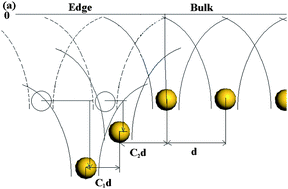
Nanoscale, 2010,2, 2160-2163
https://doi.org/10.1039/C0NR00273A
Single-step synthesis and magnetic separation of graphene and carbon nanotubes in arc discharge plasmas
Simultaneous production of graphene flakes and carbon nanotubes in arc discharge, followed by the effective magnetic separation and deposition at different surfaces is demonstrated by splitting the high-temperature growth and low-temperature separation zones of the discharge using a non-uniform magnetic field and custom-designed catalyst.

Nanoscale, 2010,2, 2281-2285
https://doi.org/10.1039/C0NR00416B
Polyelectrolyte and carbon nanotube multilayers made from ionic liquid solutions
Polyelectrolyte and carbon nanotube multilayer films are prepared from ionic liquid solutions, demonstrating the potential of ionic liquids as a non-aqueous working solvent for layer-by-layer assembly.
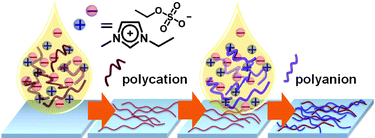
Nanoscale, 2010,2, 2084-2090
https://doi.org/10.1039/B9NR00333A
High purity graphenes prepared by a chemical intercalation method
A simple method of fabricating few-layer and single-layer graphene which could be used for production on a gram scale is described.
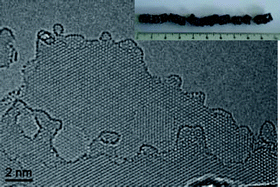
Nanoscale, 2010,2, 2139-2143
https://doi.org/10.1039/C0NR00248H
Self-aligned nanolithography by selective polymer dissolution
We report a novel nanolithography technique for self-aligned polymer patterning on metallic nanowires and graphene ribbons. We show that by dissolution of polymers through localized heating, nanoscale trench structures can be fabricated to selectively expose the underlying conductive material, providing potential use for site-specific modification or functionalization of nanostructure devices.

Nanoscale, 2010,2, 2302-2306
https://doi.org/10.1039/C0NR00398K
A nanostructured graphene /polyaniline hybrid material for supercapacitors
In this paper, a novel method for the preparation of a nanostructured polyaniline/graphene hybrid material was developed. In addition to its thin, uniformity and flexible merits, it also shows excellent electrochemical performances than pristine individuals for supercapacitors.
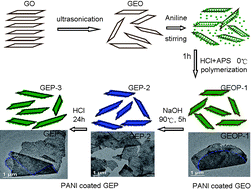
Nanoscale, 2010,2, 2164-2170
https://doi.org/10.1039/C0NR00224K
Covalent modification and exfoliation of graphene oxide using ferrocene
Covalent functionalization of the graphene oxide with ferrocene on solid phase alumina results in intercalation and exfoliation of graphene oxide to single-layer ferrocene–graphene oxide.

Nanoscale, 2010,2, 1762-1766
https://doi.org/10.1039/C0NR00024H
Excitation profile of surface-enhanced Raman scattering in graphene –metal nanoparticle based derivatives
We examine the SERS excitation profile for graphene with Au nanoparticles attached by means of chemical reduction. A charge-transfer resonance is observed at 2.09 eV.

Nanoscale, 2010,2, 1461-1466
https://doi.org/10.1039/C0NR00135J
Nanoelectronic biosensors based on CVD grown graphene
We demonstrate the use of large-sized CVD grown graphene films configured as field-effect transistors for real-time biomolecular sensing.
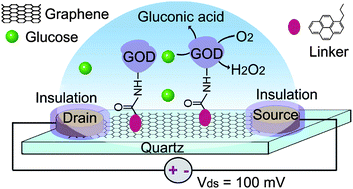
Nanoscale, 2010,2, 1485-1488
https://doi.org/10.1039/C0NR00142B
A graphene -enhanced molecular beacon for homogeneous DNA detection
Sequence-specific detection of DNA targets by combining molecular beacons with graphene oxide.

Nanoscale, 2010,2, 1021-1026
https://doi.org/10.1039/B9NR00401G
Decorating graphene oxide with CuO nanoparticles in a water –isopropanol system
A facile chemical procedure capable of aligning CuO nanoparticles on graphene oxide in a water–isopropanol system is described.

Nanoscale, 2010,2, 988-994
https://doi.org/10.1039/B9NR00414A
Atomic-scale observation of rotational misorientation in suspended few-layer graphene sheets
We observe rotational misorientation in 2, 4 and 6 layers of suspended graphene sheets, which gives Moiré patterns in the HRTEM.

Nanoscale, 2010,2, 700-708
https://doi.org/10.1039/B9NR00256A
Preparation of graphene by a low-temperature thermal reduction at atmosphere pressure
Graphene oxide in a mixture of DMAc and water can be easily reduced to graphene by simply heating it.
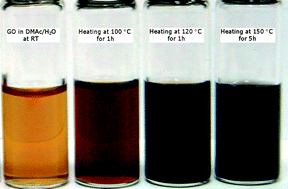
Nanoscale, 2010,2, 559-563
https://doi.org/10.1039/B9NR00191C
Odd–even width effect on persistent current in zigzag hexagonal graphene rings
The electronic structure and the persistent current of zigzag hexagonal graphene rings are studied, determined by the even or odd quality of the ring width, which may be experimentally observable.
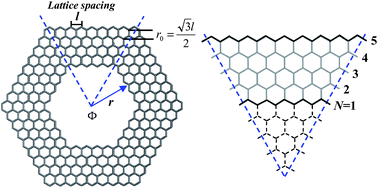
Nanoscale, 2009,1, 387-390
https://doi.org/10.1039/B9NR00044E
Nanostructured Pt decorated graphene and multi walled carbon nanotube based room temperature hydrogen gas sensor
Herein, we report the fabrication of hydrogen gas sensors based on noble nanometal decorated one dimensional multi walled carbon nanotubes and two dimensional graphene by a simple drop casting technique.

Nanoscale, 2009,1, 382-386
https://doi.org/10.1039/B9NR00015A
About this collection
To celebrate the 2010 Nobel Prize for Physics awarded to Andre Geim and Konstantin Novoselov “for groundbreaking experiments regarding the two-dimensional material graphene”, Nanoscale has prepared a Web Collection on Graphene. 17 high-quality, excellent articles and reviews on Graphene. Congratulations (and thanks!) to the Laureates.